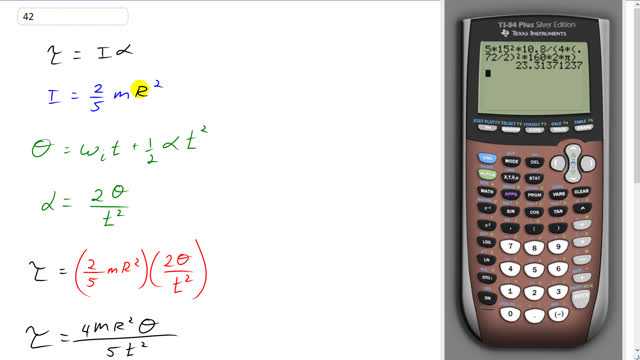
A 0.72-m-diameter solid sphere can be rotated about an axis through its center by a torque of which accelerates it uniformly from rest through a total of 160 revolutions in 15.0 s. What is the mass of the sphere?

In order to watch this solution you need to have a subscription.
This is Giancoli Answers with Mr. Dychko. The torque on this sphere equals its moment of inertia times its angular acceleration. So the formula for the moment of inertia of a sphere is two-fifths times its mass times its radius squared and to figure out α, we'll use this formula saying the angular displacement is the initial angular velocity times time which the term is 0 since it starts from rest plus one-half times angular acceleration times time squared. And we can rearrange this by multiplying both sides by 2 and dividing both sides by time squared and then switch the sides around and you get that α is 2 times Θ over t squared. So we substitute for each of these factors— I and α here— to get that the torque is two-fifths times mR squared times 2Θ over t squared. And then we write that out a little bit more nicely and we get 2 times 2 makes 4mR squaredΘ on top divided by 5 times t squared. Then we can solve for m, or the mass, by multiplying both sides by 5 times time squared divided by 4R squaredΘ and switch the sides around and we get mass is 5 times time squared times the torque divided by 4 times the sphere radius squared times the angular displacement. So we have to turn this 0.72 meter diameter into a radius so I divide that by 2 before squaring it and then turn this 160 revolutions into radians by multiplying by 2π radians per revolution and otherwise just plug stuff in and you get 5 times 15 seconds squared times 10.8 newton meters torque divided by 4 times 0.72 over 2 squared times 160 times 2π and you get about 23 kilograms must be the mass of the sphere.